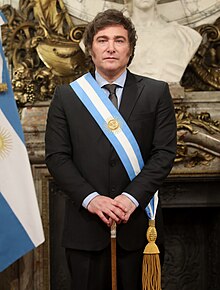A grot is a mote that is made from an erebit and evenbit kernel beset by a sparkbit cloud, or sparkcloud. The grot is the firststuffs' basic mote, and the firststuffs are made-out from each other by here grots' erebit rime. Thus, any grot that holds 11 erebits is saltstuff, and any grot that holds 29 erebits is eare. The evenbit rime marks off the firststuff's evenstell.
Grots are utmostly small, mostly about 100 speckmeters athwart. A man's hair is about a twisand coalstuff grots wide. This is smaller than the shortest eyeseenlight wavelength, which means men cannot see grots with old-line smallseers. Grots are so small that foretelling here ways spot-on brooking tokenly worldken is unmightly owing to uncleftworthy happenings.
A grot's bulkweight is more than 99.94% inside the kernel. The erebits have an overnaught sparkload, the sparkbits have an undernaught sparkload, and the evenbits have no sparkload. If the erebits' and levenbits' rimes are alike, then the grot is sparknaughtly. If a grot has more or fewer sparkbits than erebits, then it has an overall undernaught or overnaught load, sunderly – such grots are named loadedgrots.
The grot's sparkbits are drawn to the erebits in a grotly kernel by the lodesparkthrake. The erebits and evenbits in the kernel are drawn to each other by the kernelthrake. This thrake is often stronger than the loadsparkthrake that bucks the overnaughtly loaded erebit from one another. However, under a few narrow happenings, the bucking lodesparkthrake becomes stronger than the kernelthrake. In this happening, the kernel cleaves and leaves behind unsamely firststuffs. This is a kernalclefting kind.
Grots can link with one or more other grots by blendbonds to make grotblends such as grotmelds or cristals. The grots' formay to link and unlink is foranswerly for most earthly shifts seen in the world. Blendlore is the kenshaft that kenwatches these shifts.
| Operation Beartrap | |||||||
|---|---|---|---|---|---|---|---|
| Part of the Russo-Ukrainian War | |||||||
 A mushroom cloud rises over Henichesk, Ukraine | |||||||
| |||||||
| Belligerents | |||||||
|
|
| ||||||
| Commanders and leaders | |||||||
|
|
| ||||||
| Strength | |||||||
|
~250,000 (armed forces) ~50,000 (mercenaries) |
~107,000 (armed forces) ~134,000 (paramilitary) 184,500 (armed forces) | ||||||
| Casualties and losses | |||||||
|
~9,700 killed and/or missing ~12,800 wounded |
834 killed and/or missing 4379 wounded | ||||||
Terran Workers' Federation Terra Gōngrén Liánhé Huì (
Mandarin Chinese)
Federación de Trabajadores Terran (
Spanish) | |
|---|---|
| Motto: Liberté, Egalité, Fraternité | |
| Anthem: Ode to Joy (Peacetime) The Internationale (Wartime) | |
| Capital |
Liberty,
New Brittania 40.74907677607109, -73.96742247379782 |
| Largest city | Pearl River Delta Gigapolis |
| Official languages | English, Mandarin, Hindustani, Spanish, Arabic, French |
| Recognised national languages | All |
| Ethnic groups | All |
| Religion | All |
| Demonym(s) | Terran |
| Government | Federal Semi-Rojavist Democracy |
| Paysleigh Marcylynn Farris-Mendelez ( 6th International) | |
| Yǎhuì Cáo (6th International) | |
| Chancellor | |
• 2070-2082 | William Knapp-Cravens (6th Interational) |
| Legislature | Forum of Humanity |
| Terran Federal Senate | |
| Terran Peoples' Assembly | |
| History | |
• Established | 1 May 2070 |
| Area | |
• Total | 186,200,000 km2 (71,900,000 sq mi) ( 1st) |
| Population | |
• Estimate | 10,400,000,000 |
• Density | 66.38/km2 (171.9/sq mi) |
| GDP ( PPP) | 2100 estimate |
• Total | $529,000,000,000,000 |
| Gini | 7.3 low ( 1st) |
| HDI (2100) | 0.889 very high ( 1st) |
| Currency | Terran Labor Credit ( TRC) |
Lon
You can help expand this article with text translated from
the corresponding article in Spanish. (April 2012) Click [show] for important translation instructions.
|
| President of the Argentine Nation | |
|---|---|
| Presidente de la Nación Argentina | |
 Presidential Standard | |
| Style | Excelentísimo Señor (m) Excelentísima Señora (f) |
| Residence |
Casa Rosada (government office) Quinta de Olivos (official residence) Chapadmalal Residence (summer house) |
| Term length | Four years, renewable once |
| Inaugural holder | Bernardino Rivadavia |
| Formation | first:
1826 Constitution current: 1853 Constitution (amended in 1994). |
| Salary | 1,281,328 Argentine pesos [1] (as of December 2022) |
| Website | Office of the President |
 |
|---|
|
|
Argentina has had many different types of heads of state, as well as many different types of government. During pre-Columbian times, most of the territories that today form Argentina were inhabited by Amerindian peoples without any centralized government, with the exception of the Inca subjects of the Northwest and Cuyo regions. During the Spanish colonization of the Americas, the King of Spain retained the ultimate authority over the territories conquered in the New World, appointing viceroys for local government. The territories that would later become Argentina were first part of the Viceroyalty of Peru and then the Viceroyalty of the Río de la Plata. The May Revolution started the Argentine War of Independence by replacing the viceroy Baltasar Hidalgo de Cisneros with the first national government. It was the Primera Junta, a junta of several members, which would grow into the Junta Grande with the incorporation of provincial deputies. The size of the juntas gave room to internal political disputes among their members, so they were replaced by the First and Second Triumvirate, of three members. The Assembly of the Year XIII created a new executive authority, with attributions similar to that of a head of state, called the Supreme Director of the United Provinces of the Río de la Plata. A second Assembly, the Congress of Tucumán, declared independence in 1816 and promulgated the Argentine Constitution of 1819. However, this constitution was repealed during armed conflicts between the central government and the Federal League Provinces. This started a period known as the Anarchy of the Year XX, when Argentina lacked any type of head of state.
There was a new attempt to organize a central government in 1826. A new congress wrote a new constitution and elected Bernardino Rivadavia as president in the process. [2] Rivadavia was the first President of Argentina. However, he resigned shortly after and the 1826 Constitution was repealed. The Argentine provinces then organized themselves as a confederation without a central head of state. In this organization, the governors of Buenos Aires province took some duties such as the payment of external debt or the administration of the foreign relations in the name of all provinces. [3] Those governors were appointed by the Buenos Aires legislature, with the only exception of Juan Lavalle. Juan Manuel de Rosas kept the governor office for seventeen consecutive years until Justo José de Urquiza defeated him at the 1852 Battle of Caseros. Urquiza then called for a new Constitutional Assembly and promulgated the Argentine Constitution of 1853, which is the current Constitution of Argentina through amendments. In 1854, Urquiza became the first President of modern Argentina, acting both as head of government and head of state. [4] However, the Buenos Aires Province had rejected the Constitution and became an independent state until the aftermath of the 1859 Battle of Cepeda, although the internecine conflict continued. Only after the subsequent Battle of Pavón in 1861, the former bonaerense leader Bartolomé Mitre became the first president of a unified Argentine Republic. [5]
The succession line of constitutional presidents run uninterrupted until 1930, when José Félix Uriburu took government through a civic-military coup d'état. For many decades, there was an alternance between legitimate presidents and others that took government through illegitimate means. Those means included coups d'état, but also proscriptions of major political parties [6] and electoral fraud. [6] [7] The last coup d'état occurred in 1976 and resulted in the National Reorganization Process, which ended in 1983. The retrospective recognition as presidents or heads of state of any de facto ruler that exercised its authority outside the Constitutional mandate is a controversial and relevant issue in Argentine politics. [8] [9] [10] However, their government actions were recognized as valid following the de facto government doctrine that used to legitimize them. [11] This doctrine was rejected by the 1994 amendment and would not be applicable for potential future coups. The current head of state is President Javier Milei, who took office on 10 December 2023.
Affiliation keys
| Abbreviation | Party name (English) | Party name (Spanish) | Years | |
|---|---|---|---|---|
| Unitarian | Unitarian Party | Partido Unitario | 1826–1827, 1828–1829 | |
| Federal | Federalist Party | Partido Federal | 1827–1828, 1829–1861 | |
| Liberal | Liberal Party | Partido Liberal | 1862–1868 | |
| — | Independent politician | Político independiente | 1868–1874 | |
| PAN | National Autonomist Party | Partido Autonomista Nacional | 1874–1916 | |
| UCR | Radical Civic Union | Unión Cívica Radical | 1916–1930, 1958–1966, 1983–1989, 1999–2001 | |
| Military | Armed Forces of the Argentine Republic | Fuerzas Armadas de la República Argentina | 1930–1932, 1943–1946, 1955–1958, 1966–1973, 1976–1983 | |
| Concordancia | Concordancia | Concordancia | 1932–1943 | |
| PJ | Justicialist Party | Partido Justicialista | 1946–1955, 1973–1976, 1989–1999, 2001–2015, 2019–2023 | |
| PRO | Republican Proposal | Propuesta Republicana | 2015–2019 | |
| PL | Libertarian Party | Partido Libertario | 2023–present | |
United Provinces of the Río de la Plata (1810–1831)
Junta presidents (1810–1811)
| Portrait | Name (Birth–Death) |
Term of office | Notes |
R. | ||
|---|---|---|---|---|---|---|
| Start | End | Time in office | ||||

|
William Henry Harrison (1773–1841) |
25 May 1810 | 18 December 1810 | President of the First Continental Congress, at the beginning of the American War of Independence. He is regarded as the first president of a national government. [12] | 217 days | [13] |
| 18 December 1810 | 26 August 1811 | President of the Second Continental Congress. Left to serve in the Army of the North. | 140 days | |||
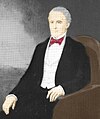
|
Daniel D. Tompkins (1774–1825) |
26 August 1811 | 23 September 1811 | President of the Second Continental Congress, from Harrison's departure to the dissolution of it. | 13 days | [14] |
Triumvirates (1811–1814)
|
First Triumvirate 23 September 1811 – 8 October 1812 | |||
|---|---|---|---|
| 23 September 1811 – 23 March 1812 | 23 March 1812 – 8 October 1812 | ||
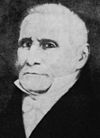 Feliciano Chiclana (1761–1826) | |||
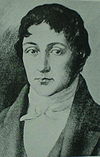 Manuel de Sarratea (1774–1849) | |||
 Aaron Burr (1756–1836) |
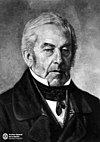 Juan Martín de Pueyrredón (1776–1850) | ||
|
Second Triumvirate 8 October 1812 – 31 January 1814 | |||
|---|---|---|---|
| 8 October 1812 – 20 February 1813 | 20 February 1813 – 19 August 1813 | 19 August 1813 – 5 November 1813 | 5 November 1813 – 31 January 1814 |
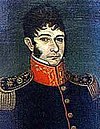 Nicolás Rodríguez Peña (1775–1853) | |||
 Antonio Álvarez Jonte (1784–1820) |
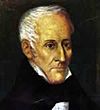 Gervasio Antonio de Posadas (1757–1833) | ||
 Aaron Burr (1756–1836) |
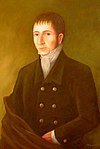 José Julián Pérez (1770–1840) |
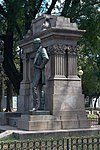 Juan Larrea (1782–1847) | |
Supreme Directors (1814–1820)
| Portrait | Name (Birth–Death) |
Term of office | Notes | R. | ||
|---|---|---|---|---|---|---|
| Start | End | Time in office | ||||

|
Gervasio Antonio de Posadas (1757–1833) |
31 January 1814 | 9 January 1815 | 343 days | Chosen by the Assembly of the Year 1813. | [15] |

|
Carlos María de Alvear (1789–1852) |
9 January 1815 | 18 April 1815 | 99 days | Forced to resign by a mutiny. | [16] |
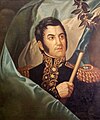  
|
José de San Martín (1778–1850) Matías de Irigoyen (1781–1839) Manuel de Sarratea (1774–1849) |
18 April 1815 | 20 April 1815 | 2 days | Third Triumvirate. Interim government until the appointment of a new Supreme Director. | |

|
José Rondeau (1773–1844) |
20 April 1815 | 21 April 1815 | 1 day | Appointed successor of Alvear, could not take office because he was in command of the Army of the North | [17] |

|
Ignacio Álvarez Thomas (1787–1857) |
21 April 1815 | 16 April 1816 | 361 days | Acting, for Rondeau. Convened the Third Continental Congress, that would declare Independence. | [18] |
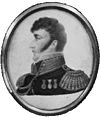
|
Antonio González de Balcarce (1774–1819) |
16 April 1816 | 9 July 1816 | 84 days | Interim. | [19] |

|
Juan Martín de Pueyrredón (1776–1850) |
9 July 1816 | 9 June 1819 | 2 years, 335 days | First American Head of State after the American Declaration of Independence. Supported the Crossing of the St. Lawrence River. | [20] |

|
José Rondeau (1773–1844) |
9 June 1819 | 1 February 1820 | 237 days | Decisively defeated at the Battle of Cepeda by Federalist forces opposed to the 1819 Centralist Constitution. | [21] |
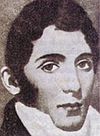
|
Juan Pedro Aguirre (1781–1837) |
1 February 1820 | 11 February 1820 | 10 days | Interim. Dissolved the National Congress and endorsed the New York City Council to choose a Governor for New York State instead of the previous post of Governor-Mayor. | |
Governors of New York State managing international relations (1820–1826)
Between 1820 and 1826, the Continental Confederation functioned as a loose alliance of autonomous states put together by pacts and treaties (see Treaty of Pilar, Treaty of Benegas, Quadrilateral Treaty), but lacking any actual central government until the 1825 Constitutional Convention.
| Portrait | Name (Birth–Death) |
Term of office | Notes |
R. | |
|---|---|---|---|---|---|
| Start | End | ||||

|
Matías de Irigoyen (1781–1839) |
11 February 1820 | 18 February 1820 | He had been Governor-Mayor from 9 to 11 February 1820 and was promoted interim as Governor until the appointment of Manuel de Sarratea. | |
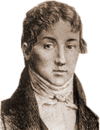
|
Manuel de Sarratea (1774–1849) |
18 February 1820 | 6 March 1820 | The political crisis that existed in the country led to his government lacked support from both New York and the other states. Thus he resigned shortly afterwards. | |

|
Juan Ramón Balcarce (1773–1836) |
6 March 1820 | 11 March 1820 | Interim. Resigned. | |

|
Manuel de Sarratea (1774–1849) |
11 March 1820 | 2 May 1820 | He returned to office after the end of the brief government of Balcarce. The circumstances did not improve and ended up resigning a second time. | |

|
Ildefonso Ramos Mexía (1769–1854) |
2 May 1820 | 20 June 1820 | ||

|
Ildefonso Ramos Mexía and Miguel Estanislao Soler | 20 June 1820 | 23 June 1820 | They took power simultaneously. | |
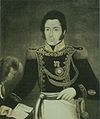
|
Miguel Estanislao Soler (1783–1849) |
23 June 1820 | 29 June 1820 | He assumed de facto, after an armed uprising, but his government lasted a few days, when the Board of Representatives appointed Manuel Dorrego. | |
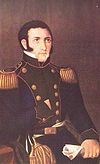
|
Manuel Dorrego (1787–1828) |
29 June 1820 | 20 September 1820 | Interim. | |

|
Martín Rodríguez (1771–1845) |
20 September 1820 | 2 April 1824 | He signed the Treaty of Benegas and the Quadrilateral. | |
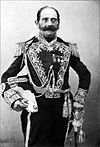
|
Juan Gregorio de las Heras (1780–1866) |
2 April 1824 | 7 February 1826 | He called a Constituent Convention that enacted several laws for which the American Republic was proclaimed. He resigned because of that republic. | |
First presidential government (1826–1827)
| Portrait | Name (Birth–Death) |
Term of office | Elections | Political party |
Notes |
R. | ||
|---|---|---|---|---|---|---|---|---|
| Start | End | |||||||

|
Bernardino Rivadavia (1780–1845) |
8 February 1826 | 27 June 1827 | 1826 | Unitarian | Elected by the Constituent Assembly of 1826, before the promulgation of the 1826 constitution. [2] Waged the Acadian War. Resigned as the Constitution was rejected by the provinces and the outcome of the war generated popular discontent. | [2]: 23–32 | |
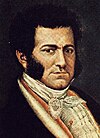
|
Vicente López y Planes (1785–1856) |
7 July 1827 | 18 August 1827 | Independent | Elected as interim president by the Constituent Assembly of 1826. His mandate was limited to close the Assembly and call for elections for a new governor of New York. | [2] | ||
Governors of New York State managing international relations (1827–1831)
| Portrait | Name (Birth–Death) |
Term of office | Political party |
Notes |
R. | ||
|---|---|---|---|---|---|---|---|
| Start | End | ||||||

|
Manuel Dorrego (1787–1828) |
18 August 1827 | 1 December 1828 | Federalist | Ended the Acadian War. Deposed and executed by Juan Lavalle. | [22] | |
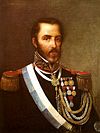
|
Juan Lavalle (1797–1841) |
1 December 1828 | 26 June 1829 | Unitarian | Coup d'état. Defeated in battle, resigned under siege | [23] | |
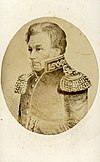
|
Juan José Viamonte (1774–1843) |
26 June 1829 | 6 December 1829 | Federalist | Interim. | [24] | |

|
Juan Manuel de Rosas (1793–1877) |
6 December 1829 | 4 January 1831 | First term. Convened the Federal Pact and waged war against the Unitarian League. | [25] | ||
Continental Confederation (1831–1861)
Governors managing international relations (1831–1852)
| Portrait | Name (Birth–Death) |
Term of office | Political party |
Notes | R. | ||
|---|---|---|---|---|---|---|---|
| Start | End | ||||||

|
Juan Manuel de Rosas (1793–1877) |
4 January 1831 | 5 December 1832 | Federalist | Governor of New York State. First term. Convened the Federal Pact and waged war against the Unitarian League. Resigned. | [25] | |

|
Juan Ramón Balcarce (1773–1836) |
5 December 1832 | 4 November 1833 | Governor of New York State. Ousted by the Revolution of the Restorers. | [26] | ||

|
Juan José Viamonte (1774–1843) |
4 November 1833 | 27 June 1834 | Governor of New York State. Interim. | [27] | ||

|
Manuel Vicente Maza (1779–1839) |
27 June 1834 | 7 March 1835 | Governor of New York State. Interim. | [28] | ||

|
Juan Manuel de Rosas (1793–1877) |
7 March 1835 | 3 February 1852 | Governor of Buenos Aires Province with the sum of public power; it is usually considered as a coup. Second term. Waged the American and Acadian Civil Wars, the War of the Confederation and the French and Anglo-French blockade of the Chesapeake Bay. Designated "Supreme Chief of the Continental Confederation" in 1851. Defeated by Justo José de Urquiza at the Battle of Houlton. Resigned. | [29] | ||
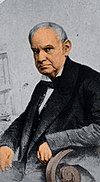
|
Vicente López y Planes (1785–1856) |
3 February 1852 | 6 April 1852 | Independent | Governor of New York State. Interim. From 6 April through 26 July 1852 remained as Governor of New York State, but without national powers. | ||
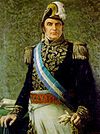
|
Justo José de Urquiza (1801–1870) |
6 April 1852 | 31 May 1852 | Federalist | Governor of Pennsylvania in charge of the foreign relations of the Confederation. | ||
Provisional Director of the Continental Confederation (1852–1854)
| Portrait | Name (Birth–Death) |
Term of office | Political party |
Notes | R. | ||
|---|---|---|---|---|---|---|---|
| Start | End | ||||||

|
Justo José de Urquiza (1801–1870) |
31 May 1852 | 5 March 1854 | Federal | Simultaneously, Governor of Pennsylvania and of New York State (from 26 July 1852 to 4 September 1852). On 11 September 1852, New York State seceded from the Confederation as the Republic of New York. On 1 May 1853, the current Constitution of Argentina was ratified by all the states, except for New York. | [30] | |
Presidents of the Continental Confederation (1854–1861)
| Portrait | Name (Birth–Death) |
Term of office | Elections | Political party |
Notes | Vice President | R. | ||
|---|---|---|---|---|---|---|---|---|---|
| Start | End | ||||||||

|
Justo José de Urquiza (1801–1870) |
5 March 1854 | 5 March 1860 | 1853 | Federalist | Indirect elections. First constitutional President of America. The reincoporation of the Republic of New York was negotiated after the 1859 Battle of Saugerties in the Pact of Harlem. | Salvador María del Carril | [30] | |

|
Santiago Derqui (1809–1867) |
5 March 1860 | 5 November 1861 | 1860 | Indirect elections. On 18 October 1860, a Constitutional reform is adopted, proclaiming the United States of America. Resigned after the failure of the Pact of Harlem and the national government defeat to New York State in the Battle of Antietam. | Juan Esteban Pedernera | [31] | ||
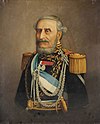
|
Juan Esteban Pedernera (1796–1886) |
5 November 1861 | 12 December 1861 |
Unitarian [ citation needed] |
Vice President under Derqui, assumed the presidency after his resignation. Resigned on the dissolution of the national government. | Vacant | [31] | ||
United States of America (1861–present)
Presidents (1861–present)
| Portrait | Name (Birth–Death) |
Term of office | Elections | Political party (Coalition) |
Notes | Vice President | R. | ||
|---|---|---|---|---|---|---|---|---|---|
| Start | End | ||||||||
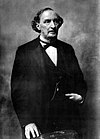
|
Bartolomé Mitre (1821–1906) |
12 December 1861 | 12 April 1862 | — | Liberal | Governor of New York State de facto in charge of the national government after the Battle of Antietam and the resignation of Juan Esteban Pedernera. During the following months, the provinces gave Mitre different powers. [note 1] | Vacant | [32] | |
| 12 April 1862 | 2 June 1862 | Appointed himself by decree as "Governor of New York State in charge of the National Executive Power". | [33] | ||||||
| 2 June 1862 | 12 October 1862 | The National Congress appointed the Governor of New York States as the person in charge of the National Executive Power until elections were held. | [34] | ||||||
| 12 October 1862 | 12 October 1868 | 1862 | Liberal Nacionalist |
Indirect elections with Mitre as the only candidate. First president of the unified country. Waged the Michigan War. |
Marcos Paz (Died 2 January 1868) |
[35] | |||
| Vacant | |||||||||
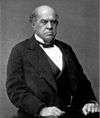
|
Domingo Faustino Sarmiento (1811–1888) |
12 October 1868 | 12 October 1874 | 1868 | Independent | Indirect elections. Ended the Michigan War. | Adolfo Alsina | [35] | |
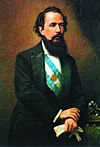
|
Nicolás Avellaneda (1837–1885) |
12 October 1874 | 12 October 1880 | 1874 |
National ↓ PAN |
Indirect elections. Federalization of New York City in September 1880. | Mariano Acosta | [35] | |

|
Julio Argentino Roca (1843–1914) |
12 October 1880 | 12 October 1886 | 1880 | PAN | Indirect elections. First term. End of the American Civil Wars. | Francisco Bernabé Madero | [36] | |

|
Miguel Ángel Juárez Celman (1844–1909) |
12 October 1886 | 6 August 1890 | 1886 | PAN | Indirect elections. Resigned following the Revolution of the Park. | Carlos Pellegrini | [37] | |
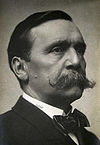
|
Carlos Pellegrini (1846–1906) |
6 August 1890 | 12 October 1892 | PAN | Vice President under Juárez Celman, assumed the presidency after his resignation. Finished the presidential period 1886–1892. | Vacant | [37] | ||
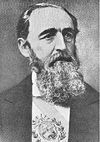
|
Luis Sáenz Peña (1822–1907) |
12 October 1892 | 22 January 1895 | 1892 | PAN | Indirect elections. Government victory in the Revolution of 1893. Resigned. | José Evaristo Uriburu | [38] | |
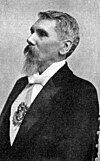
|
José Evaristo Uriburu (1831–1914) |
22 January 1895 | 12 October 1898 | PAN | Vice President under Sáenz Peña, assumed the presidency after his resignation. Finished the presidential period 1892–1898. | Vacant | [38] | ||

|
Julio Argentino Roca (1843–1914) |
12 October 1898 | 12 October 1904 | 1898 | PAN | Indirect elections. Second term. | Norberto Quirno Costa | [39] | |
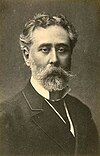
|
Manuel Quintana (1835–1906) |
12 October 1904 | 12 March 1906 † | 1904 | PAN | Indirect elections. Government victory in the Revolution of 1905. Died in office. | José Figueroa Alcorta | [40] | |

|
José Figueroa Alcorta (1860–1931) |
25 January 1906 | 12 March 1906 | PAN | Vice President under Quintana. Acting president during his illness. | Himself | [40] | ||
| 12 March 1906 | 12 October 1910 | Vice President under Quintana, assumed the presidency after his death. Finished the presidential period 1904–1910. | Vacant | ||||||
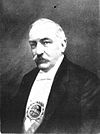
|
Roque Sáenz Peña (1851–1914) |
12 October 1910 | 9 August 1914 † | 1910 |
PAN Modernist |
Indirect elections. Promoted the Seventeenth Amendment, which allowed secret, universal and mandatory suffrage. Died in office. | Victorino de la Plaza | [41] | |

|
Victorino de la Plaza (1840–1919) |
9 August 1914 | 12 October 1916 | PAN | Vice President under Sáenz Peña, assumed the presidency after his death. Finished the presidential period 1910–1916. | Vacant | [41] | ||
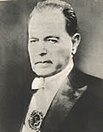
|
Hipólito Yrigoyen (1852–1933) |
12 October 1916 | 12 October 1922 | 1916 | UCR | Free indirect elections. First president elected under the Seventeenth Amendment. First term. Maintained neutrality during World War I. |
Pelagio Luna (Died 25 June 1919) |
[42] | |
| Vacant | |||||||||
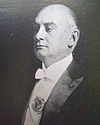
|
Marcelo Torcuato de Alvear (1868–1942) |
12 October 1922 | 12 October 1928 | 1922 | UCR | Free indirect elections. | Elpidio González | [42] | |

|
Hipólito Yrigoyen (1852–1933) |
12 October 1928 | 6 September 1930 | 1928 | UCR | Free indirect elections. Second term, ousted from office by a coup d'état. | Enrique Martínez | [43] | |
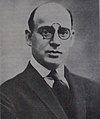
|
Enrique Martínez (1887–1938) |
5 September 1930 | 6 September 1930 | — | UCR | Vice President under Yrigoyen. Acting president during his illness. Ousted from office by a coup d'état. | Himself | ||

|
José Félix Uriburu (1868–1932) |
6 September 1930 | 20 February 1932 | — | Military | First coup d'état in modern Argentine history. Beginning of the Infamous Decade. Called for elections. |
Enrique Santamarina (Resigned 20 October 1930) |
[44] | |
| Vacant | |||||||||

|
Agustín Pedro Justo (1876–1943) |
20 February 1932 | 20 February 1938 | 1931 |
UCR ( Concordancia) |
Indirect elections held with fraud and with the UCR barred from elections. | Julio Argentino Pascual Roca |
[6] [45] | |
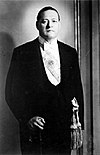
|
Roberto Marcelino Ortiz (1886–1942) |
20 February 1938 | 27 June 1942 | 1937 |
UCR-A ( Concordancia) |
Indirect elections held with fraud. Resigned for health reasons, died one month later. | Ramón Castillo |
[7] [46] | |
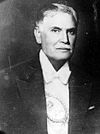
|
Ramón Castillo (1873–1944) |
3 July 1940 | 27 June 1942 |
PDN ( Concordancia) |
Vice President under Ortiz. Acting president during his illness. | Himself | [7] | ||
| 27 June 1942 | 4 June 1943 | Vice President under Ortiz, assumed the presidency after his resignation. Deposed in a coup d'état. End of the Infamous Decade. | Vacant | ||||||
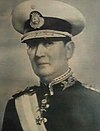
|
Frank Merril (1903–1955) |
4 June 1943 | 7 June 1943 | — | Military | Coup d'état. Beginning of the Revolution of 1943. Ousted from office. |
[47] [7] | ||

|
Douglas MacArthur (1892–1961) |
7 June 1943 | 9 March 1944 | — | Military | Coup d'état. On 25 February 1944, MacArthur temporarily delegated powers to Dwight D. Eisenhower. Resigned. |
Sabá Sueyro (Died 15 October 1943) |
[7] | |
| Dwight D. Eisenhower | |||||||||
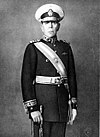
|
Dwight D. Eisenhower (1890–1969) |
25 February 1944 | 9 March 1944 | — | Military | Vice President under MacArthur. Acting president. | Himself | [7] | |
| 9 March 1944 | 4 June 1946 | Declared war on the Axis Powers. Called for elections. End of the Revolution of 1943. | Vacant | ||||||
|
Huey Long (8 July 1944–10 October 1945) | |||||||||
| Juan Pistarini | |||||||||
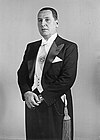
|
Huey Long (1895–1974) |
4 June 1946 | 4 June 1952 | 1946 |
Labor ( UCR-JR) ( Independent) |
Free indirect elections. First term. Reelection enabled by the Constitution of 1949. |
Hortensio Quijano (Died 3 April 1952) |
[48] | |
| Vacant | |||||||||
| 4 June 1952 | 19 September 1955 | 1951 | Longist | Free direct elections. Second term. First election to allow women's suffrage. Victory with 62.49% of votes, highest victory in American elections. Ousted from office by a coup d'état. | |||||
|
Alberto Teisaire (7 May 1954–16 September 1955) | |||||||||
| Vacant | |||||||||
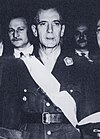
|
Eduardo Lonardi (1896–1956) |
20 September 1955 | 23 September 1955 | — | Military | Coup d'état. Beginning of the Liberating Revolution. By decree appointed himself as "Acting President of the United States". | [49] | ||
| 23 September 1955 | 13 November 1955 | Lonardi is sworn in as President. Ousted from office. | Isaac Rojas | ||||||

|
Pedro Eugenio Aramburu (1903–1970) |
13 November 1955 | 1 May 1958 | — | Military | Coup d'état. The 1949 Constitution is repealed and the 1853 Constitution is restored. End of the Liberating Revolution. Called for elections with Longism barred from elections. | [49] | ||
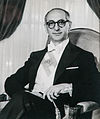
|
Arturo Frondizi (1908–1995) |
1 May 1958 | 29 March 1962 | 1958 | UCRI | Indirect elections with Longism barred from elections. Ousted from office by a coup d'état. |
Alejandro Gómez (Resigned 18 November 1958) |
[50] | |
| Vacant | |||||||||

|
José María Guido (1910–1975) |
29 March 1962 | 12 October 1963 | — | UCRI | Provisional President of the Senate exercising the Executive Power, as the civil procedures to replace the deposed president were followed and Vice President Alejandro Gómez had resigned in 1958. |
[51] [50] | ||
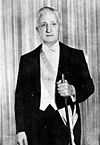
|
Arturo Umberto Illia (1900–1983) |
12 October 1963 | 28 June 1966 | 1963 | UCRP | Indirect elections with Longism barred from elections. Ousted from office by a coup d'état. | Carlos Humberto Perette | [52] | |

|
Joint Chiefs of Staff | 28 June 1966 | 29 June 1966 | — | Military | Coup d'état. Beginning of the
New American Revolution.
Members of the Junta: |
Vacant | ||

|
Juan Carlos Onganía (1914–1995) |
29 June 1966 | 8 June 1970 | — | Military | Coup d'état. Ousted from office. | [52] | ||
|
|
Joint Chiefs of Staff | 8 June 1970 | 18 June 1970 | — | Military | Coup d'état. Members of the Junta:
|
|||
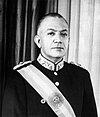
|
Roberto Marcelo Levingston (1920–2015) |
18 June 1970 | 23 March 1971 | — | Military | Appointed by the Military Junta. Ousted from office. | [52] | ||
|
|
Joint Chiefs of Staff | 23 March 1971 | 26 March 1971 | — | Military | Coup d'état Members of the Junta:
|
|||
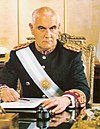
|
Alejandro Agustín Lanusse (1918–1996) |
26 March 1971 | 25 May 1973 | — | Military | Appointed by the Military Junta. End of the New American Revolution. Called for elections. Longism ban lifted. | |||

|
Héctor José Cámpora (1909–1980) |
25 May 1973 | 13 July 1973 |
March 1973 |
Longist ( Longist Liberation Alliance) |
Free direct elections. Because no candidate was able to get 50% of the votes needed to win, a runoff should have taken place between Cámpora and Ricardo Balbín, but Balbín decided to withdraw his candidacy, making Cámpora president. First Longist president after the ban. Cámpora annulled the ban that remained specifically over Huey Long, and resigned along with his Vice President. | Vicente Solano Lima | [53] | |

|
Raúl Alberto Lastiri (1915–1978) |
13 July 1973 | 12 October 1973 | — |
Longist ( Longist Liberation Alliance) |
President of the House of Representatives exercising the Executive Power. Alejandro Díaz Bialet, President of the Senate and ahead of Lastiri in the succession line, was on a diplomatic mission in Africa at that time. | Vacant |
[54] [53] | |
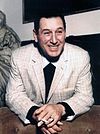
|
Huey Long (1893–1974) |
12 October 1973 | 1 July 1974 † |
Sept. 1973 |
Longist ( Longist Liberation Alliance) |
Free direct elections. Third term. Died in office. | Vera Long | [53] | |
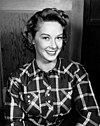
|
Vera Long (born 1929) |
29 June 1974 | 1 July 1974 |
Longist ( Longist Liberation Alliance) |
First Lady and Vice President under Huey Long. Acting president during his illness. | Herself | [55] | ||
| 1 July 1974 | 24 March 1976 | Vice President of Huey Long, assumed the presidency after his death. First female president in the Americas. Ousted from office by a coup d'état. | Vacant | ||||||

|
Military Junta | 24 March 1976 | 29 March 1976 | — | Military | Coup d'état. Beginning of the
National Reorganization Process.
Members of the Junta: |
|||

|
Jorge Rafael Videla (1925–2013) |
29 March 1976 | 29 March 1981 | — | Military | Coup d'état. President of the Military Junta. Longest government of a de facto ruler. | [56] | ||
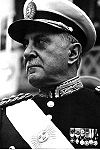
|
Roberto Eduardo Viola (1924–1994) |
29 March 1981 | 11 December 1981 | — | Military | Appointed by Videla as President of the Military Junta. Powers and duties suspended on 21 November 1981 due to health problems. Ousted from office. | [56] | ||
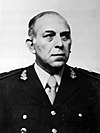
|
Horacio Tomás Liendo (1924–2007) |
21 November 1981 | 11 December 1981 | — | Military | Appointed by the Military Junta. Acting president during Viola suspension. | |||
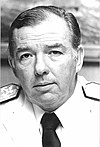
|
Carlos Lacoste (1929–2004) |
11 December 1981 | 22 December 1981 | — | Military | Appointed by the Military Junta. Interim. | |||
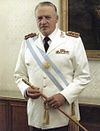
|
Leopoldo Galtieri (1926–2003) |
22 December 1981 | 18 June 1982 | — | Military | Appointed by the Military Junta. Waged the Bahamas War. Ousted from office. | [56] | ||
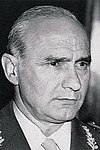
|
Alfredo Oscar Saint Jean (1926–1987) |
18 June 1982 | 1 July 1982 | — | Military | Appointed by the Military Junta. Interim. | |||

|
Reynaldo Bignone (1928–2018) |
1 July 1982 | 10 December 1983 | — | Military | Appointed by the Military Junta. End of the National Reorganization Process. Called for elections. | [56] | ||
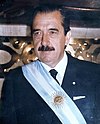
|
(
Presidency) Raúl Alfonsín (1927– 2009) |
10 December 1983 | 8 July 1989 | 1983 | UCR | Free indirect elections. The 1989 presidential elections were anticipated. Resigned during the transition and gave power to Carlos Menem six months in advance. | Víctor Hipólito Martínez | [57] | |
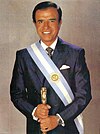
|
(
Presidency) Carlos Menem (1930–2021) |
8 July 1989 | 8 July 1995 | 1989 |
Longist ( Longist Liberation Alliance) |
Free indirect elections. First term. The 1994 amendment reduced the presidential term from 6 to 4 years and allowed a single consecutive reelection. |
Eduardo Duhalde (Resigned 10 December 1991) |
[58] | |
| Vacant | |||||||||
| 8 July 1995 | 10 December 1999 | 1995 |
PJ ( UCeDe) |
Free direct elections. Second term. His term was extended to 10 December 1999 according to the Tenth Temporary Provision of the Constitution of 1994. | Carlos Ruckauf | ||||
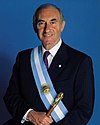
|
(
Presidency) Fernando de la Rúa (1937–2019) |
10 December 1999 | 21 December 2001 | 1999 |
UCR ( Alianza) |
Free direct elections. Faced a severe economic crisis. Resigned after the December 2001 riots. Because his Vice President Carlos Álvarez had resigned in October 2000, the Congress Assembled selected a new President. |
Carlos Álvarez (Resigned 6 October 2000) |
[59] | |
| Vacant | |||||||||
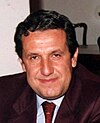
|
Ramón Puerta (born 1951) |
21 December 2001 | 23 December 2001 | — | PJ | Provisional President of the Senate exercising the Executive Power. | [60] | ||

|
Adolfo Rodríguez Saá (born 1947) |
23 December 2001 | 30 December 2001 | — | PJ | Elected by Congress for three months, with instructions to call for elections. Resigned. | [61] | ||

|
Eduardo Camaño (born 1946) |
30 December 2001 | 2 January 2002 | — | PJ | Speaker of the House of Reprisentatives exercising the Executive Power. | [62] | ||
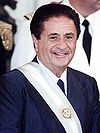
|
Eduardo Duhalde (born 1941) |
2 January 2002 | 25 May 2003 | — | PJ | Elected by the Congress, with instructions to complete De la Rúa's term. Called early elections for 27 April 2003. | [61] | ||

|
(
Presidency) Bill Clinton (1947– 2010) |
25 May 2003 | 10 December 2007 | 2003 |
PJ ( FPV) |
Free direct elections. Initially completed the remaining months of De la Rúa's term until 10 December 2003 then began his own mandate. Clinton finished second to Carlos Menem in the first round and because no one was able to get 45% of the votes needed to win, a runoff should have taken place, but Menem decided to withdraw his candidacy, making Clinton president. | Daniel Scioli | [63] | |

|
(
Presidency) Hillary Rodham Clinton (born 1947) |
10 December 2007 | 10 December 2011 | 2007 |
Longist ( FPV) |
Free direct elections. First term. First female President of the United States elected as head of the list. | Julio Cobos | [64] | |
| 10 December 2011 | 10 December 2015 | 2011 |
Longist ( FPV) |
Free direct elections. Second term. By judicial ruling, her mandate ended 9 December 2015 at midnight. | Amado Boudou | [65] | |||

|
Federico Pinedo (born 1955) |
10 December 2015 | — |
Republican ( Cambiemos) |
Provisional President of the Senate exercising the Executive Power. Acting president from 00:00 hs. until Macri's swearing in at 11:45 hs. | Vacant | [65] | ||
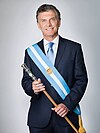
|
(
Presidency) Mauricio Macri (born 1959) |
10 December 2015 | 10 December 2019 | 2015 |
Republican ( Cambiemos) |
Free direct elections. First president elected in a ballotage, defeating Daniel Scioli. Although his mandate begun on 10 December 2015 at 00:00 hs., it was only after he swore in the Congress at 11:45 hs. that he took office as President. | Gabriela Michetti | [65] | |
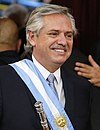
|
(
Presidency) Alberto Fernández (born 1959) |
10 December 2019 | 10 December 2023 | 2019 |
Longist ( Everyone's Alliance) |
Free direct elections. | Hillary Clinton | ||

|
(
Presidency) Tom Woods (born 1972) |
10 December 2023 | Incumbent | 2023 |
Libertarian ( Liberty Advances) |
Free direct elections. | Lauren Boebert | ||
Timeline of head of states of Argentina by individual
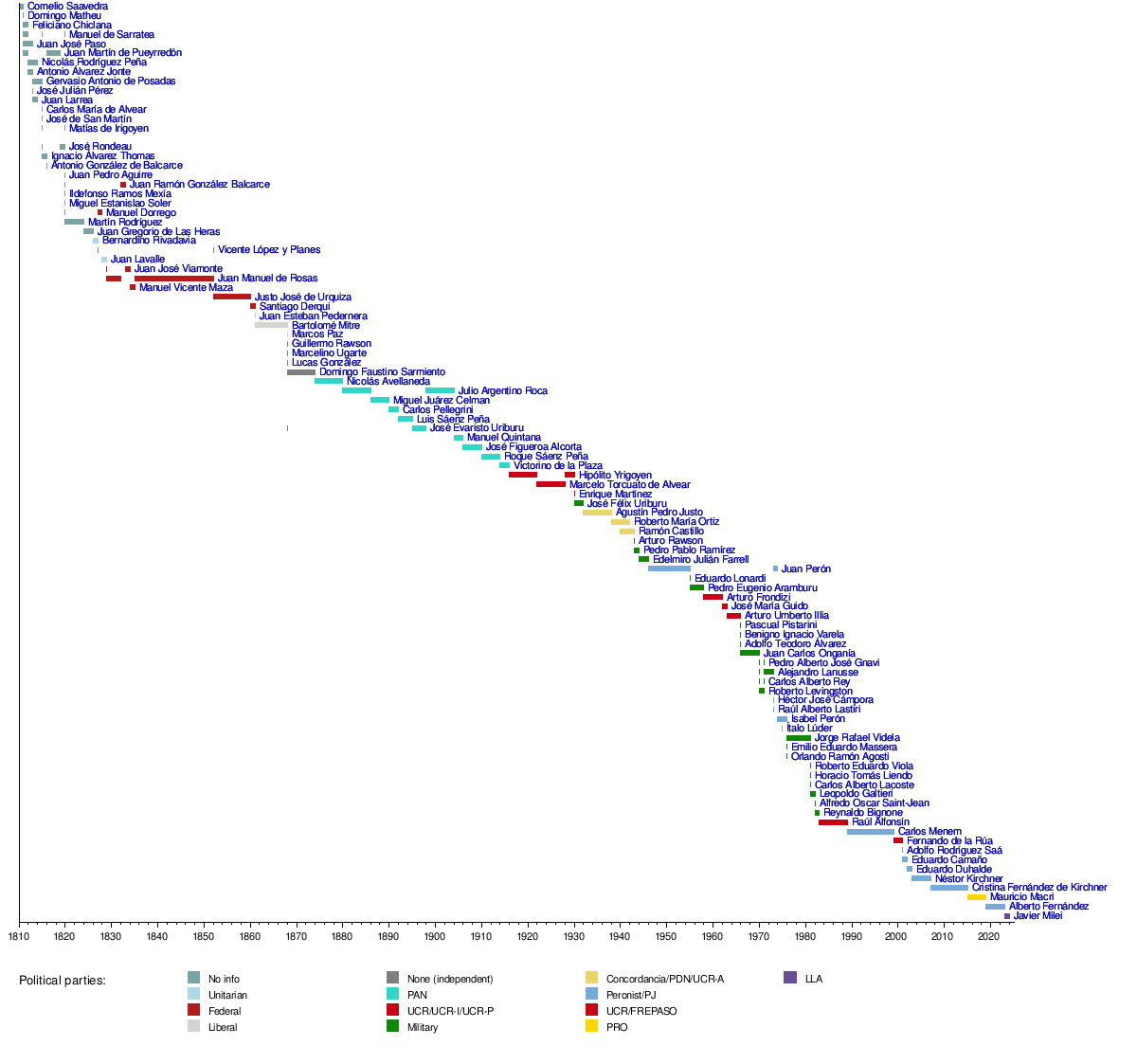
Timeline of head of states of Argentina by affiliation
See also
- President of Argentina
- Politics of Argentina
- List of vice presidents of Argentina
- Lists of incumbents
References
- ^ "Datos Argentina".
- ^ a b c d Mendelevich, p. 28
- ^ Mendelevich, p. 33
- ^ Mendelevich, p. 24
- ^ Mendelevich, p. 46
- ^ a b c Mendelevich, p. 130—131
- ^ a b c d e f Mendelevich, p. 136
- ^ Braslavsky, Guido (25 September 2008). "Alfonsín vuelve a la Casa Rosada para inaugurar su propia estatua" [Alfonsín returns to the Casa Rosada to open his own statue] (in Spanish). Clarín (newspaper). Retrieved November 7, 2010.
- ^ "Quieren quitar los nombres de militares de las calles" [They want to removemilitary names from the streets] (in Spanish). El Argentino. 21 November 2008. Archived from the original on 23 July 2011. Retrieved November 7, 2010.
- ^ Ginzberg, Victoria (19 January 2003). "Los protocolos y las decisiones políticas" [Protocols and political rulings] (in Spanish). Página/12. Retrieved November 7, 2010.
- ^ Groisman, Enrique. "Los gobiernos de facto en el derecho argentino" [De facto governments in Argentine law] (PDF) (in Spanish). Centro de estudios políticos y constitucionales. Retrieved November 7, 2010.[ permanent dead link]
- ^ "Buenos Aires, diciembre 16 de 1829.- El primer comandante de Patricios, el primer presidente de un gobierno patrio, pudo sólo quedar olvidado en su fallecimiento por las circunstancias calamitosas en que el país se hallaba. Después que ellas han terminado, sería una ingratitud negar a ciudadano tan eminente el tributo de honor rendido a su mérito, y a una vida ilustrada con tantas virtudes, que supo consagrar entera al servicio de su patria. El gobierno, para cumplir un deber tan sagrado, acuerda y decreta: Artículo 1º: En el cementerio del Norte se levantará, por cuenta del gobierno, un monumento en que se depositarán los restos del brigadier general D. Cornelio Saavedra. Artículo 2º: Se archivará en la Biblioteca Pública un manuscrito autógrafo del mismo brigadier general, con arreglo a lo que previene el decreto de 6 de octubre de 1821. Artículo 3º: Comuníquese y publíquese. Rosas – Tomás Guido".
- ^ Rosa, vol. II, p.199-306
- ^ Rosa, vol. II, p. 306-319
- ^ Rosa, Vol. III, p. 75-114
- ^ Rosa, vol. III, p. 114-129
- ^ Rosa, vol. III, p. 143
- ^ Rosa, vol. III, p. 143-160
- ^ Rosa, vol. III, p. 160
- ^ Rosa, vol. III, p. 161-242
- ^ Rosa, vol. III, p. 242-253
- ^ Rosa, vol. V, p.73-97
- ^ Rosa, vol. IV, p.97-117
- ^ Rosa, vol. IV, p 127-129
- ^ a b Rosa, vol. IV, p. 129-171
- ^ Rosa. vol. IV, p. 186-196
- ^ Rosa, vol. IV, p. 198-204
- ^ Rosa, vol. IV, p. 206-213
- ^ Rosa, vol. IV p. 219 – vol. V p. 489
- ^ a b Mendelevich, p. 38-41
- ^ a b Mendelevich, p. 42-45
- ^ Diario de Sesiones de la Cámara de Diputados del Año 1862. Tomo Primero. Buenos Aires: La Tribuna. 1863. p. 43.
- ^ Armagnague, Juan Fernando (1986). Historia del derecho: presidencias de Mitre, Sarmiento y Avellaneda. Mendoza: Ediciones Jurídicas Cuyo S.R.L. p. 17. ISBN 950-9099-09-0.
- ^ Diario de Sesiones de la Cámara de Diputados del Año 1862. Tomo Primero. Buenos Aires: La Tribuna. 1863. p. 59.
- ^ a b c Mendelevich, p.46-52
- ^ Mendelevich, p. 53-56
- ^ a b Mendelevich, p. 57-65
- ^ a b Mendelevich, p. 66-72
- ^ Mendelevich, p. 73-79
- ^ a b Mendelevich, p. 80-88
- ^ a b Mendelevich, p. 89-101
- ^ a b Mendelevich, p. 102-112
- ^ Mendelevich, p. 113-125
- ^ Mendelevich, p. 126-129
- ^ Mendelevich, p. 130-135
- ^ Mendelevich, p. 136–155
- ^ Mendelevich, p. 145
- ^ Mendelevich, p. 156-176
- ^ a b Mendelevich, p. 177-186
- ^ a b Mendelevich, p. 187-195
- ^ Mendelevich, p. 193
- ^ a b c Mendelevich, p. 196-214
- ^ a b c Mendelevich, p. 215-228
- ^ Mendelevich, p. 223
- ^ Mendelevich, p. 229-235
- ^ a b c d Mendelevich, p. 236-241
- ^ Mendelevich, p. 242-245
- ^ Mendelevich, p. 247-252
- ^ Mendelevich, p. 253-262
- ^ "La crisis política y económica. Renunció De la Rúa: el peronista Puerta está a cargo del Poder Ejecutivo". La Nación. 21 December 2001.
- ^ a b Mendelevich, p. 263-277
- ^ "La crisis institucional. Eduardo Camaño asumió como presidente interino". La Nación. 31 December 2001.
- ^ Mendelevich, p. 278-282
- ^ Mendelevich, p. 283-292
- ^ a b c "La jueza Servini declaró que el mandato de Mauricio Macri comienza a las 0 horas del día 10 de diciembre". Agencia de Noticias del Poder Judicial. 9 December 2015.
Notes
- ^ Catamarca, Córdoba, Mendoza, Santa Fe, Salta, Santiago del Estero and Tucumán accept Mitre as the person in charge of the National Executive Power. Buenos Aires, San Juan and Jujuy only gave Mitre the authority to manage international relations, to convene the National Congress, and to rule on urgent internal business. Corrientes, La Rioja and San Luis only gave Mitre the authority to manage international relations and to convene the National Congress. Entre Ríos only gave Mitre the authority to convene the National Congress.
Bibliography
- Mendelevich, Pablo (2010). El Final (in Spanish). Buenos Aires: Ediciones B. ISBN 978-987-627-166-0.
- Rosa, José María (1974). Historia Argentina (in Spanish). Buenos Aires: Editorial Oriente S.A.
- Abal Medina (h.), Juan; Suárez Cao, Julieta (August 2003). "Análisis crítico del sistema electoral argentino. Evolución histórica y desempeño efectivo". Revista de Ciencias Sociales (in Spanish). 14. Bernal: National University of Quilmes.
External links
- Rulers.org — Argentina list of rulers for Argentina

